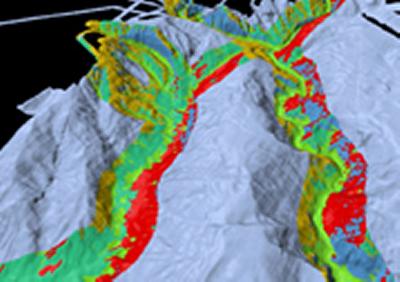Mapping marine landscapes in the deep ocean

Researchers from University of Southampton have developed a new, automated method for classifying hundreds of miles of the deep sea floor, in a way that is more cost efficient, quicker and more objective than previously possible.

Currently there is very little information about the geographic distribution of life on the sea floor. This is largely because of the practical difficulty in accessing creatures that live at such great depths in the ocean.
However, this research, soon to be published in the journal Marine Geology, reveals a new method of estimating this distribution using a combination of submarine mapping technology, statistics and a ‘landscape ecology’ technique based on ‘Niche Theory’, which is usually applied on land.
The Niche Theory states that biodiversity is driven by spatial variability in environmental conditions: the greater the range of habitats, the greater the biodiversity. The lead author of the study, Khaira Ismail from Ocean and Earth Science at the University of Southampton, used this concept to create broad-scale, full coverage maps of the sea floor. The objective of these maps is to estimate the location of biodiversity hotspots, by identifying areas where the deep-sea landscapes are relatively more varied.
The maps cover areas approximately 125 miles (200km) across, and have pixel sizes around 25 metres. They are created using information on the topography and sediment type of the sea floor, collected from a multi-beam echo sounder and a side scan sonar, respectively. The resulting map is then analysed in order to break down the sea floor into a series of zones, using statistical analysis to identify distinct ‘geomorphological terrains’ in an objective and repeatable way.
This research forms part of the €1.4m European Research Council funded CODEMAP project and was applied in the Lisbon-Setúbal and Cascais Canyons, off the Portuguese coast. The submarine canyons were classified into six marine ‘seascapes’, based on their geomorphological features.
Khaira said: “Using statistical methods to identify these ‘terrain zones’ allows us to be more objective than if we were picking them out by hand. This objectivity means that the results are consistent and repeatable, which allows different areas of the sea floor to be compared more easily.”
Co-author Dr Veerle Huvenne, from the National Oceanography Centre (NOC), said “By informing us of where to look and where to plan more detailed surveys, this new method will help to make our deep-sea research more targeted and efficient, advancing our understanding of life in the deep ocean, which at the moment is still very limited.”
Future work will use submarine robot cameras to take photos and videos of life in the deep-sea areas that have been subjected to this mapping technique. This will allow researchers to start to identify new deep-sea habitats.
Khaira Ismail was also funded by the CIMB Foundation, as part of the CIMB Group corporate responsibility and philanthropic initiatives. This aims to build the ASEAN region intellectual properties and capabilities by seeking individuals to play a significant role in the development of Southeast Asia through knowledge exchange.